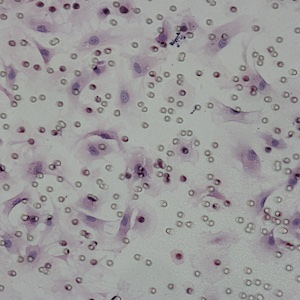Smad2/3 signaling involved in urotensin II-induced phenotypic differentiation, collagen synthesis and migration of rat aortic adventitial fibroblasts

All claims expressed in this article are solely those of the authors and do not necessarily represent those of their affiliated organizations, or those of the publisher, the editors and the reviewers. Any product that may be evaluated in this article or claim that may be made by its manufacturer is not guaranteed or endorsed by the publisher.
Authors
Objective. To investigate whether Smad2/3 signaling is involved in urotensin II (UII) induced activation of aortic adventitial fibroblasts. Materials and Methods. Growth-arrested adventitial fibroblasts were stimulated with UII in the presence or absence of urotensin II receptor (UT) antagonist SB710411 or transfected with Smad2/3 small inhibitory RNA (siRNA). UII stimulated Smad2/3 phosphorylation, α-smooth muscle actin (α-SMA), and collagen I expression and migration of adventitial fibroblasts were evaluated by western blot analysis, real-time reverse transcription polymerase chain reaction, immunofluorescence, ELISA, and transwell migration assay, respectively. Results. In cultured adventitial fibroblasts, UII time- and dose-dependently stimulated Smad2/3 protein phosphorylation, with maximal effect at 10-8 mol/l (increased by 147.2%, P<0.001). UII stimulated Smad2/3 upregulation and nuclear translocation. SB710411 significantly inhibited these effects. In addition, UII potently induced α-SMA and procollagen 1 protein or mRNA expression (P<0.01), which were completely blocked by Smad2 (decreased by 75.1%, 54.2% in protein, and by 73.3% and 38.2% in mRNA, respectively, P<0.01) or Smad3 siRNA (decreased by 80.3% and 47.0% in protein, and by 72.3% and 47.7% in mRNA, respectively, P<0.01). Meanwhile, Smad2 or smad3 siRNA significantly inhibited the UII-induced collagen 1 secretion and cell migration. Conclusions. UII may stimulate adventitial-fibroblast phenotype conversion, migration, and collagen I synthesis via phosphorylated-Smad2/3 signal transduction pathways.
Supporting Agencies
National Natural Science Foundation of China, Natural Science Foundation of Guangdong Province of ChinaHow to Cite

This work is licensed under a Creative Commons Attribution-NonCommercial 4.0 International License.
PAGEPress has chosen to apply the Creative Commons Attribution NonCommercial 4.0 International License (CC BY-NC 4.0) to all manuscripts to be published.






